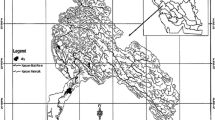Abstract
In this study, we aim to construct and apply a simple genetic algorithm (SGA) to optimize a large number of parameters of an one-box ecosystem model. The ecosystem model was used to simulate the water quality over a 6-month period based on the new observation data in an agricultural pond which was strongly influenced by a green algal bloom. Of the 54 parameters in this model, 10 important parameters were initially selected for the optimization, with one other parameter being subsequently added. The SGA program was used for three purposes, namely (1) to narrow the search space for the 10 parameters, (2) to assess the influence of the additional parameter on the optimization results, and (3) to observe the distribution and convergence of the optimized values for the 10 selected parameters. In the next step, new ranges for these 10 important parameters were assigned and the SGA was applied to all 54 model parameters to seek the optimum value for each parameter. The modeling approach and the results presented here provide valuable and reliable evidences of the optimum parameters for further simulations to clarify the mechanisms of the biochemical processes in the water.












Similar content being viewed by others
References
Arhonditsis GB, Brett MT (2005) Eutrophication model for lake Washington (USA): part II—model calibration and system dynamics analysis. Ecol Model 187(2–3):179–200
Back T, Hammel U, Schwefel H (1997) Evolutionary computation: comments on the history and current state. IEEE Trans Evol Comput 1(1):3–17
Catherine A, Escoffier N, Belhocine A, Nasri AB, Hamlaoui S, Yéprémian C (2012) On the use of the FluoroProbe®, a phytoplankton quantification method based on fluorescence excitation spectra for large-scale surveys of lakes and reservoirs. Water Res 46(6):1771–1784
Coley AD (1999) An introduction to genetic algorithms for scientists and engineers. World Scientific Publishing, Singapore
Dowd M (2005) A bio-physical coastal ecosystem model for assessing environmental effects of marine bivalve aquaculture. Ecol Model 183(2–3):323–346
Downing JA, Prairie YT, Cole JJ, Duarte CM, Tranvik LJ, Striegl RG (2006) The global abundance and size distribution of lakes, ponds, and impoundments. Limnol Oceanogr 51(5):2388–2397
Edna G (1987) Nutrient limitation of phytoplankton biomass in a brackish water bay highly influenced by river discharge. Estuar Coast Shelf Sci 25(5):555–565
Goldberg DE (1989) Genetic algorithms in search, optimization and machine learning. Addison-Wesley Longman Publishing, Boston, MA
Hiramatsu K, Oshima Y, Inoue S, Shikasho S (2005) Numerical modeling of environmental behavior and fate of tributyltin in a semi-closed bay. Paddy Water Environ 3(2):79–92
Jeffrey SW, Anderson JM (2000) Emiliania huxleyi (Haptophyta) holds promising insights for photosynthesis. J Phycol 36:449–452
Köhler J, Hoeg S (2000) Phytoplankton selection in a river–lake system during two decades of changing nutrient supply. Hydrobiologia 424(1–3):13–24
Liu S, Butler D, Brazier R, Heathwaite L, Khu S (2007) Using genetic algorithms to calibrate a water quality model. Sci Total Environ 374(2–3):260–272
Mulligan AE, Brown LC (1998) Genetic algorithms for calibrating water quality models. J Environ Eng 124(3):202–211
Nguyen DT, Harada M, Hiramatsu K (2010) Evaluation of the water-quality dynamics in a eutrophic agricultural pond by using a one-box ecosystem model considering several algal groups. Paddy Water Environ 8(4):301–318
Odum HT, Odum E (2000) Modeling for all scales: an introduction to system simulation. Academic Press, London
OECD (1982) Eutrophication of waters: monitoring, assessment and control. Technical report OECD (organization for economic cooperation and development). Environmental Directorate, OECD, DAS/DSI/82:75-85
Radtke E, Straškraba M (1980) Self-optimization in a phytoplankton model. Ecol Model 9(C):247–268
Riebesell U (1989) Comparison of sinking and sedimentation rate measurements in a diatom winter/spring bloom. Mar Ecol Prog Ser 54(1–2):109–119
Sakshaug E, Holm-Hansen O (1986) Photoadaptation in antarctic phytopfankton: variations in growth rate, chemical composition and P versus I curves. J Plankton Res 8(3):459–473
Scheffer M (2005) Ecology of shallow lakes. Kluwer Academic Publishers, Dordrecht, p 384
Scheffer M, Carpenter S, Foley JA, Folke C, Walker B (2001) Catastrophic shifts in ecosystems. Nature 413(6856):591–596
Søndergaard M, Jeppesen E (2007) Anthropogenic impacts on lake and stream ecosystems, and approaches to restoration. J Appl Ecol 44(6):1089–1094
Tsuchiyama F (2003) The aquatic environment of irrigation ponds. J Jpn Soc Water Environ 26:246–251 (in japanese)
Acknowledgments
This research was partially supported by the FY 2012-2014 JSPS Core-to-Core Program (B. Asia-Africa Science Platforms) Collaborative Project for Soil and Water Conservation in Southeast Asian Watersheds and FY2011-2015 JSPS Grant-in-Aid for Scientific Research (B)(Project number 23380144).
Author information
Authors and Affiliations
Corresponding author
Rights and permissions
About this article
Cite this article
Do Thuy, N., Harada, M., Hiramatsu, K. et al. Application of a simple genetic algorithm for the calibration of aquatic ecosystem model of an agricultural pond. Paddy Water Environ 12, 1–15 (2014). https://doi.org/10.1007/s10333-012-0353-z
Received:
Revised:
Accepted:
Published:
Issue Date:
DOI: https://doi.org/10.1007/s10333-012-0353-z



